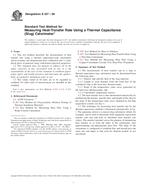Potřebujeme váš souhlas k využití jednotlivých dat, aby se vám mimo jiné mohly ukazovat informace týkající se vašich zájmů. Souhlas udělíte kliknutím na tlačítko „OK“.
ASTM E457-08
Standard Test Method for Measuring Heat-Transfer Rate Using a Thermal Capacitance (Slug) Calorimeter
Automaticky přeložený název:
Standardní zkušební metoda pro měření tepla, přenosová rychlost použití tepelného nádoby (Slug) kalorimetru
NORMA vydána dne 1.5.2008
Informace o normě:
Označení normy: ASTM E457-08
Poznámka: NEPLATNÁ
Datum vydání normy: 1.5.2008
Kód zboží: NS-46866
Počet stran: 7
Přibližná hmotnost: 21 g (0.05 liber)
Země: Americká technická norma
Kategorie: Technické normy ASTM
Anotace textu normy ASTM E457-08 :
Keywords:
calorimeter, heat transfer rate, slug calorimeter, thermal capacitance, Calorimeter--aerospace applications, Heating tests--aerospace materials, Heat transfer, Slug calorimeter, Thermal capacitance, ICS Number Code 17.200.10 (Heat. Calorimetry)
Doplňující informace
| Significance and Use | ||||||||||
|
The purpose of this test method is to measure the rate of thermal energy per unit area transferred into a known piece of material (slug) for purposes of calibrating the thermal environment into which test specimens are placed for evaluation. The calorimeter and holder size and shape should be identical to that of the test specimen. In this manner, the measured heat transfer rate to the calorimeter can be related to that experienced by the test specimen. The slug calorimeter is one of many calorimeter concepts used to measure heat transfer rate. This type of calorimeter is simple to fabricate, inexpensive, and readily installed since it is not water-cooled. The primary disadvantages are its short lifetime and relatively long cool-down time after exposure to the thermal environment. In measuring the heat transfer rate to the calorimeter, accurate measurement of the rate of rise in back-face temperature is imperative. In the evaluation of high-temperature materials, slug calorimeters are used to measure the heat transfer rate on various parts of the instrumented models, since heat transfer rate is one of the important parameters in evaluating the performance of ablative materials. Regardless of the source of thermal energy to the calorimeter (radiative, convective, or a combination thereof) the measurement is averaged over the calorimeter surface. If a significant percentage of the total thermal energy is radiative, consideration should be given to the emissivity of the slug surface. If non-uniformities exist in the input energy, the heat transfer rate calorimeter would tend to average these variations; therefore, the size of the sensing element (that is, the slug) should be limited to small diameters in order to measure local heat transfer rate values. Where large ablative samples are to be tested, it is recommended that a number of calorimeters be incorporated in the body of the test specimen such that a heat transfer rate distribution across the heated surface can be determined. In this manner, more representative heat transfer rate values can be defined for the test specimen and thus enable more meaningful interpretation of the test. The slug selection may be determined using the nomogram as a guide (see Appendix X1). |
||||||||||
| 1. Scope | ||||||||||
|
1.1 This test method describes the measurement of heat transfer rate using a thermal capacitance-type calorimeter which assumes one-dimensional heat conduction into a cylindrical piece of material (slug) with known physical properties. 1.2 This standard does not purport to address all of the safety concerns, if any, associated with its use. It is the responsibility of the user of this standard to establish appropriate safety and health practices and determine the applicability of regulatory limitations prior to use. 1.3 The values stated in SI units are to be regarded as standard. No other units of measurement are included in this standard. Note 1—For information see Test Methods E 285, E 422, E 458, E 459, and E 511. |
||||||||||
| 2. Referenced Documents | ||||||||||
|
Doporučujeme:
EviZak - všechny zákony včetně jejich evidence na jednom místě
Poskytování aktuálních informací o legislativních předpisech vyhlášených ve Sbírce zákonů od roku 1945.
Aktualizace 2x v měsíci !
Chcete vědět více informací? Podívejte se na tuto stránku.




 Cookies
Cookies
